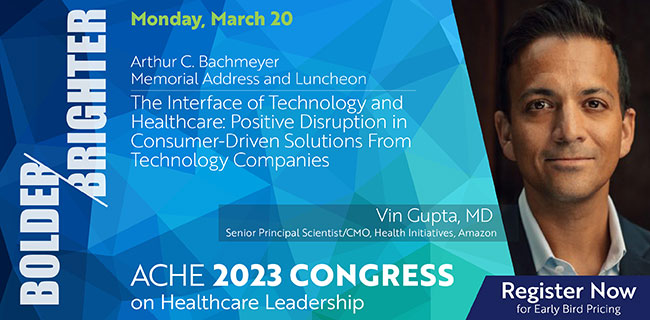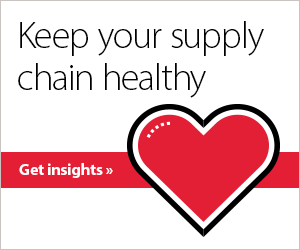
- Monthly Membership Perk:
Assessing Stress and Burnout: Techniques for Today’s Healthcare Professional - Final Takeaways and Predictions on Healthcare Supply Chain Challenges
- Congress 2023: Gain Expert Insights Into Hot-Topic Issues
- Double Down on and Redeem Leader-to-Leader Reward Points by Dec. 31
- As One Community Is Lost, Another Awaits
- CMS Proposes Rule to Expand Access to Health Information, Improve Prior Authorization
Monthly Membership Perk:
Assessing Stress and Burnout: Techniques for Today’s Healthcare Professional
You may recall the research findings “Factors Affecting Burnout Among Healthcare Leaders” that ACHE released in November, which indicated that one-third of healthcare leaders surveyed reported having burnout scores in the high range. These findings were one of several based on a survey conducted in June 2021 to examine burnout and other stress-related symptoms among healthcare administrators.
The topic of burnout continues to be prevalent within the healthcare profession. That is why this month, we are offering healthcare leaders a free resource that provides strategies to prevent burnout. In this chapter from Preventing Burnout and Building Engagement in the Healthcare Workplace, Second Edition, author Jonathon R.B. Halbesleben, PhD, introduces a variety of options for assessing stress and burnout, focusing on some of the more popular, feasible techniques for healthcare professionals.
We hope you enjoy this Monthly Membership Perk, and we thank you for being a part of the ACHE community.
Final Takeaways and Predictions on Healthcare Supply Chain Challenges
“As I reflect on the healthcare supply chain trends predicted in 2022, some of the trends remain and some new challenges are quickly emerging,” says Joe Walsh, founder/CEO of Supply Chain Sherpas, who continues to work with Cardinal Health on a variety of initiatives as a trusted supply chain and commercialization expert.
Supply chain resilience continues to be a priority for most providers, distributors and manufacturers, according to Walsh. Fortunately, technology is quickly emerging to help the healthcare field improve its resilience in some areas, including:
- Product criticality segmentation, or the ability to determine the criticality of specific items based on their potential to disrupt the supply chain. This informs which products you must have under certain disruption scenarios.
- End-to-end visibility, or the ability to transparently exchange demand signals and supply availability from the point of use to the point of raw materials, while anticipating disruptive events.
- Response plan, or the ability to pre-define how to mitigate risk in the event of a disruption scenario.
“New headwinds are quickly emerging as we turn our attention toward 2023. The perfect financial storm is brewing, especially on the provider front,” Walsh says. “Supply chain teams will need to balance their organization’s short-term needs to stabilize their income statement with their strategic agenda to build a more resilient supply chain.”
Another emerging trend affecting the supply chain industry is insufficient talent in the pipeline, according to Walsh. “People are the most valuable and essential resource in any supply chain. The best strategies, processes, governance and technology are limited by how prepared leaders are for certain disruption scenarios. Leadership preparedness plans must remain a priority for healthcare leaders in 2023,” Walsh says.
Visit Cardinal Health’s Supply Chain Solutions Center to learn more about current supply chain challenges and how health system leaders can best respond to them.
Cardinal Health, an ACHE Premier Corporate Partner, provided the content above.
Congress 2023: Gain Expert Insights Into Hot-Topic Issues
ACHE’s Congress on Healthcare Leadership, Monday, March 20, to Thursday, March 23, remains the premier event dedicated to advancing healthcare leadership excellence for many reasons, including the opportunity to learn from experts within healthcare and beyond about critical issues facing the field. Following are previews of sessions that will address hot topics such as advancing health equity, retail health and wellness, automation in logistics and technology, health policy and politics, and innovating responsibly.
Tuesday, March 21
- Join Vivian S. Lee, MD, PhD, president, Verily Health Platforms, for “Hot Topic: Realizing the Promise of Precision Health to Advance Health Equity.” During her presentation, Lee will identify approaches for leveraging data to advance health equity and describe how technology can be used to deliver personalized care at scale.
- Leading experts in the health retail space Marcus Osborne, retail health expert/former senior vice president, Walmart Health, and Caitlin Donovan, global head, Uber Health, will discuss how healthcare delivery models are evolving to meet consumer demands during “Hot Topic: The Next Phase of Retail Health and Wellness.”
- Keller Rinaudo, founder/CEO of Zipline, a company that uses drones to deliver life-saving medical supplies on-demand, will present “Hot Topic: The 4th Industrial Revolution.” During this session, Rinaudo will discuss the changes we can expect at a time in which consumers will see a huge shift toward automation in logistics and technology.
Wednesday, March 22
- Join American Hospital Association executives Richard J. Pollack, president/CEO, and Stacey Hughes, executive vice president, government relations and public policy, for a deep dive into the intricate and shifting world of healthcare policy and politics during “Hot Topic: AHA Health Policy and Politics Update.”
- General Catalyst Executive-in-Residence Stephen K. Klasko, MD, will address the need for the next generation of healthcare executives to engage in responsible innovation practices that prioritize mission and margin for both the patients and the communities they serve during “Hot Topic: Responsible Innovation in the Age of Digital Health: The Expanding Opportunities for Healthcare CEOs.”
If you haven’t already reserved your spot with one of our registration options, don’t delay! Education sessions fill up quickly. Visit ache.org/Congress to register and learn more.
Additionally, ACHE offers a limited number of tuition waivers for specific educational offerings—including Congress—to ACHE members whose organizations lack the resources to fund their tuition for education programs. Learn more here, and be sure to apply by the Monday, Jan. 23, deadline.
Double Down on and Redeem Leader-to-Leader Reward Points by Dec. 31
Members have until Dec. 31 to receive double the points they can earn when they refer colleagues to join ACHE through the Leader-to-Leader Rewards Program and to redeem any points earned in 2021 before they expire.
The Leader-to-Leader Rewards Program recognizes ACHE members with reward points when they recruit colleagues and encourage current Members to advance to Fellow. Members will earn twice the reward points for referring new members to ACHE, but only for applications received through Dec. 31. Reward points can be redeemed as soon as they are earned and up to Dec. 31 in the year after points were earned. Points can be redeemed for $25 discount coupons or ACHE merchandise, such as a UV phone sanitizer with a wireless charging pad, a one-year CEO Circle membership (for CEOs only), ACHE face masks and more.
More importantly, by referring colleagues to join ACHE, members are introducing individuals to benefits such as:
- Access to ACHE’s unique array of programs and activities, content and research.
- The opportunity to earn the distinction of board certification as a Fellow of ACHE.
- Exclusive career resources such as ACHE’s online Job Center.
Visit ache.org/L2L today to learn more and start recruiting new members and earning rewards. If you have any questions, please contact the Customer Service Center at (312) 434-9400 or contact@ache.org.
As One Community Is Lost, Another Awaits
In a recent Healthcare Executive article, a seasoned healthcare professional shares the secret sauce to a successful retirement.
“I am not sure many of us realize the impact of our work community,” writes Susan Brown, president, Kiwi Healthcare Consulting, White Plains, N.Y., and an ACHE Member. “We pass the medical centers which are now calling us to turn toward them, but we don’t. It’s no longer our place, it is now the time for others to excel in our spaces. There is a grieving period, but it will end and be replaced by a period of reflection and the question: Now what?”
In “As One Community Is Lost, Another Awaits,” Brown—who is also emeritus executive vice president, Greenwich Hospital/Yale New Haven (Conn.) Health System—contemplates life after retirement for healthcare professionals, and the idea that even though we are losing a workplace community, we are in fact gaining a new one.
This new community will be “built to reflect our value in this new environment,” and it will allow us to finally make time for family and other interests. “Whatever the path we choose for ourselves, there is now time to cultivate our connections to our redeveloped cooperative,” Brown says.
Read the full article to learn more about cultivating community after retirement, available only on HealthcareExecutive.org/WebExtras.
CMS Proposes Rule to Expand Access to Health Information, Improve Prior Authorization
Last week, the Centers for Medicare & Medicaid Services issued a proposed rule that would improve patient and provider access to health information and streamline processes related to prior authorization for medical items and services. CMS proposes to modernize the healthcare system by requiring certain payers to implement an electronic prior authorization process, shorten the time frame for certain payers to respond to prior authorization requests, and establish policies to make the prior authorization process more efficient and transparent. The rule also proposes to require certain payers to implement standards that would enable data exchange from one payer to another payer when a patient changes payers or has concurrent coverage, which is expected to help ensure that complete patient records would be available throughout the patient transitions between payers.
These proposed requirements would generally apply to Medicare Advantage organizations, state Medicaid and Children’s Health Insurance Program agencies, Medicaid managed care plans, CHIP managed care entities and Qualified Health Plan issuers on the Federally facilitated Exchanges, promoting alignment across coverage types. CMS estimate that efficiencies introduced through these policies would save physician practices and hospitals more than $15 billion over a 10-year period.
For more information about the proposed rule, the following resources are available:
- CMS press release.
- CMS fact sheet.
- “Policies and Technology for Interoperability and Burden Reduction” from CMS’ Office of Burden Reduction & Health Informatics.
Information about the proposed rule and other recent CMS news can also be found in the Dec. 8 MLN Connects newsletter—a weekly CMS publication.


